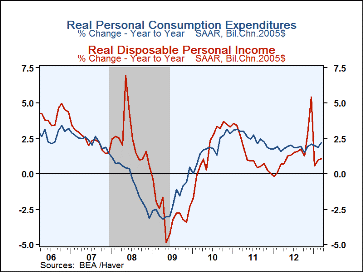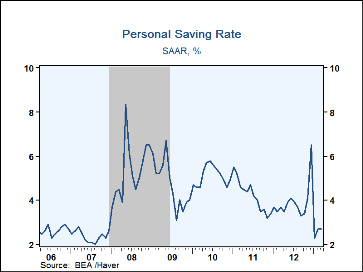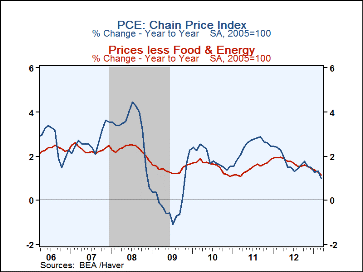 Global| Apr 29 2013
Global| Apr 29 2013U.S. Personal Income & Spending Nudge Higher
by:Tom Moeller
|in:Economy in Brief
Summary
Personal income inched up 0.2% during March (2.5% y/y) following an unrevised 1.1% advance during February. The rise fell short of consensus expectations for a 0.4% increase. Rental income again advanced 1.9% (12.8% y/y) and [...]
 Personal income inched up 0.2% during March (2.5% y/y)
following an unrevised 1.1% advance during February. The rise fell short
of consensus expectations for a 0.4% increase. Rental income again
advanced 1.9% (12.8% y/y) and proprietors income gained a strong 0.7%
(6.7% y/y). Dividend income also was firm and rose 0.6% (8.6% y/y).
Strength in these areas was, however, offset by moderation elsewhere.
Wages & salaries rose 0.2% (2.5% y/y) following February's 0.7% jump.
Transfer receipts also gained just 0.2% (3.5% y/y) while interest income
fell 1.2% (-1.3% y/y) for the third consecutive month.
Personal income inched up 0.2% during March (2.5% y/y)
following an unrevised 1.1% advance during February. The rise fell short
of consensus expectations for a 0.4% increase. Rental income again
advanced 1.9% (12.8% y/y) and proprietors income gained a strong 0.7%
(6.7% y/y). Dividend income also was firm and rose 0.6% (8.6% y/y).
Strength in these areas was, however, offset by moderation elsewhere.
Wages & salaries rose 0.2% (2.5% y/y) following February's 0.7% jump.
Transfer receipts also gained just 0.2% (3.5% y/y) while interest income
fell 1.2% (-1.3% y/y) for the third consecutive month.
A modest 0.2% rise (3.2% y/y) in personal consumption expenditures accompanied the slim gain in income. No change in spending was expected. It followed a 0.7% gain during February but was held back by a 4.9% decline (-5.0% y/y) in gasoline expenditures. Motor vehicle expenditures were roughly unchanged (+9.3% y/y) as was spending on home furnishings & appliances (1.8% y/y). Services spending gained 0.7% (3.8% y/y) reflecting a 1.6% jump (5.8% y/y) in recreation. Apparel spending slipped 0.1% (+0.9% y/y) while recreational goods outlays fell 0.8% (+2.1% y/y).
The equal gains in income & spending left the personal savings rate stable m/m at 2.7%. The level remained well below the 3.7% rate 12 months ago and the 4.0%-to-5.5% averages of the prior four years.
The PCE chain price index slipped 0.1% (+1.0% y/y), driven lower by a 4.1% drop (-2.9% y/y) in gasoline & energy prices. Elsewhere, durable goods prices fell 0.2%% (-1.7% y/y) while apparel prices fell 1.1% (+1.3% y/y). Food prices ticked up 0.1% (1.1% y/y) and services prices also inched up 0.1% (1.7% y/y). Excluding food & energy, the price index was unchanged (1.1% y/y).
Adjusted for price changes, disposable income during March rose 0.3% (1.1% y/y) while real spending also gained 0.3% (2.2% y/y).
The personal income & consumption figures are available in Haver's USECON and USNA databases. The consensus expectation figure is in the AS1REPNA database.
| Personal Income & Outlays (%) | Mar | Feb | Jan | Y/Y | 2012 | 2011 | 2010 |
|---|---|---|---|---|---|---|---|
| Personal Income | 0.2 | 1.1 | -3.6 | 2.5 | 3.5 | 5.1 | 3.8 |
| Wages & Salaries | 0.2 | 0.7 | -0.6 | 2.5 | 3.3 | 4.0 | 2.1 |
| Disposable Personal Income | 0.2 | 1.1 | -4.0 | 2.0 | 3.3 | 3.8 | 3.8 |
| Personal Consumption Expenditures | 0.2 | 0.7 | 0.3 | 3.2 | 3.7 | 5.0 | 3.8 |
| Personal Saving Rate | 2.7 | 2.7 | 2.3 | 3.7 (Mar'12) |
3.9 | 14.2 | 5.1 |
| PCE Chain Price Index | -0.1 | 0.4 | 0.1 | 1.0 | 1.7 | 2.4 | 1.9 |
| Less Food & Energy | 0.0 | 0.1 | 0.2 | 1.1 | 1.7 | 1.4 | 1.5 |
| Real Disposable Income | 0.3 | 0.7 | -4.0 | 1.1 | 1.5 | 1.3 | 1.8 |
| Real Personal Consumption Expenditures | 0.3 | 0.3 | 0.2 | 2.2 | 1.9 | 2.5 | 1.8 |
Tom Moeller
AuthorMore in Author Profile »Prior to joining Haver Analytics in 2000, Mr. Moeller worked as the Economist at Chancellor Capital Management from 1985 to 1999. There, he developed comprehensive economic forecasts and interpreted economic data for equity and fixed income portfolio managers. Also at Chancellor, Mr. Moeller worked as an equity analyst and was responsible for researching and rating companies in the economically sensitive automobile and housing industries for investment in Chancellor’s equity portfolio. Prior to joining Chancellor, Mr. Moeller was an Economist at Citibank from 1979 to 1984. He also analyzed pricing behavior in the metals industry for the Council on Wage and Price Stability in Washington, D.C. In 1999, Mr. Moeller received the award for most accurate forecast from the Forecasters' Club of New York. From 1990 to 1992 he was President of the New York Association for Business Economists. Mr. Moeller earned an M.B.A. in Finance from Fordham University, where he graduated in 1987. He holds a Bachelor of Arts in Economics from George Washington University.








